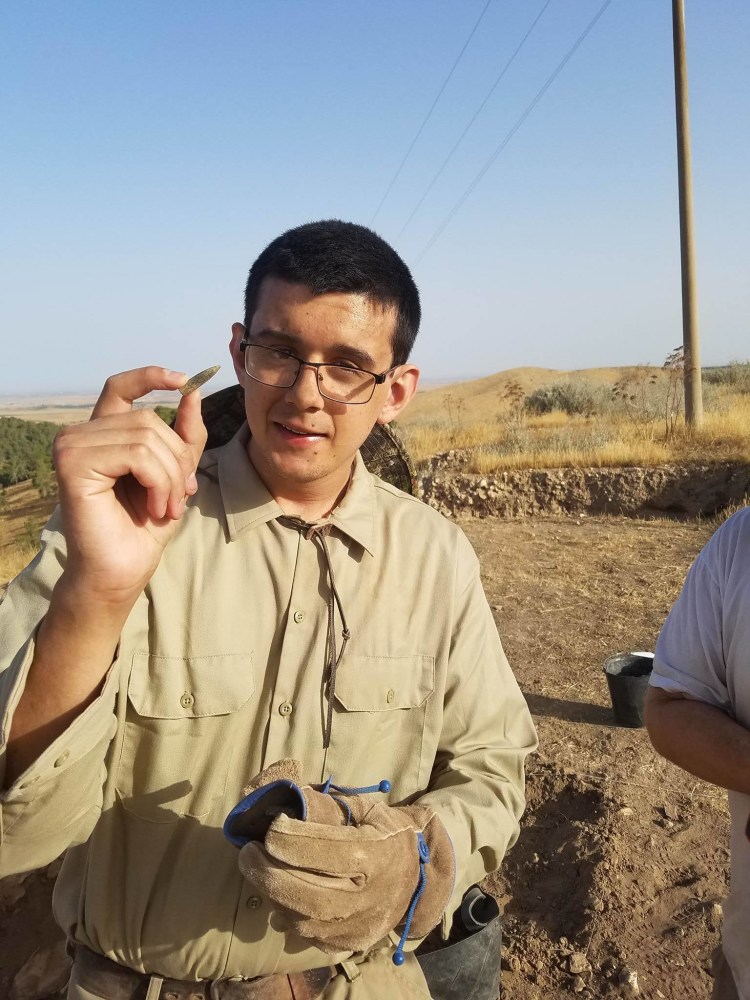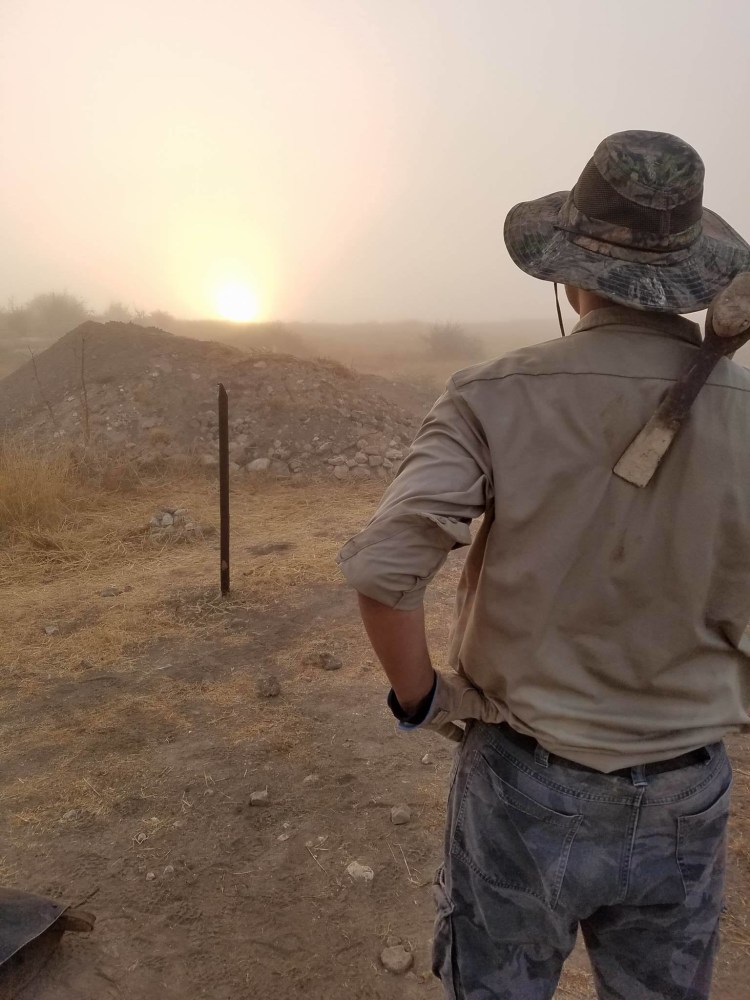Tyler Willrich
Tyler Willrich received an undergraduate travel grant from TIJS to enable him to participate in the Summer 2016 archaeological dig at Tell Halif, Israel.
Thank You
 I cannot begin to convey my gratitude for the amazing opportunity you afforded me this summer with the TIJS summer grant. I am a first generation student who comes from a low income background, and without the assistance provided through the Tam Institute I would not have been able to receive credit for my excursion and fully explore the amazing field of archaeology during the excavation. I hope that I did the Institute’s contribution honor with my hard work this summer in the field school.
I cannot begin to convey my gratitude for the amazing opportunity you afforded me this summer with the TIJS summer grant. I am a first generation student who comes from a low income background, and without the assistance provided through the Tam Institute I would not have been able to receive credit for my excursion and fully explore the amazing field of archaeology during the excavation. I hope that I did the Institute’s contribution honor with my hard work this summer in the field school.
Thanks to your assistance I was able to travel to the Lahav kibbutz located at the southwestern edge of the West Bank inside of Israel. This kibbutz is situated next to Tell Halif and served as the base of operations for the Lahav research project which tasks itself in the excavation of the Tell. Just as a refresher, a Tell is a manmade structure of overlapping layers of mudbrick that pile atop one another to form an artificial hill over centuries of occupation. Digging through them allows us to document and explore the different time periods and occupation levels at the site. Certain occupation levels at Tell Halif have at times been identified as biblical Rimmon.
The TIJS student grant allowed me to assist in the excavations of the Iron Age II Jewish settlement inside the Tell that was destroyed by the Assyrians in King Sennacherib’s invasion of Judah and Israel around 700 BCE. This destruction layer has left the precious remains of what an Iron Age Jewish settlement looked like and offers us some great insights into what life for an average joe must have been like as we explored the pillared residences along the wall, overall allowing the excavation to contribute greatly to both Jewish studies and also to the growing field of residential archaeology.
The 2016 excavation season at Tell Halif in the fourth phase of the Lahav Research Project was as  bountiful in findings and data for the site as it was in experience and development for myself as a person. This season the project sought to remove the baulk along A8 in field five in order to connect and clarify the pillared house which the baulk divided, the project also sought to expand A7 in field five to better understand the courtyard/street outside of the residential dwellings. I worked primarily in A7 with a group comprised of students from Emory and William and Mary, while the students from William Jessup operated primarily in A8.
bountiful in findings and data for the site as it was in experience and development for myself as a person. This season the project sought to remove the baulk along A8 in field five in order to connect and clarify the pillared house which the baulk divided, the project also sought to expand A7 in field five to better understand the courtyard/street outside of the residential dwellings. I worked primarily in A7 with a group comprised of students from Emory and William and Mary, while the students from William Jessup operated primarily in A8.
Immediately scraping the surface of the site yielded interesting finds, such as a spare bullet from around the early 20th century, and though such finds did not always yield useful data in regards to the research subject of our season’s excavation, they helped illustrate how rich with history the entire area was. After the site was cleaned and the process of removing the baulk had begun, A8 began to produce pertinent finds that told us more about the activities that occurred in the pillared house and what the residence looked like at the time of destruction. A8 also produced some surprising revelations as the baulk was methodically taken down. Up to last season’s excavation, it was known that the area of the Tell was under use for agricultural purposes during the Roman and Byzantine periods, but it was not known if the Romans or succeeding Byzantines had occupied the Tell properly. As the Baulk was being brought down a noticeable structure of large stones appeared to pop out. This structure can be dated along with the pottery from its stratigraphic layer to be from the Roman period, and confirms that there was occupation during the Roman period on the Tell along with the activities that were occurring around it at the time.
Beneath the Roman structure the team encountered the destruction layer from the 8th century. As they reached this layer the team clarified the relationship between fields four and five, completing the pillared house. The Team continued work in L8 of field four meticulously as the destruction layers was absolutely lousy with artifacts and saturated with data that needed to be carefully collected. Looking through the layers as they worked the team could see how it seemed to go from pottery to surface intermittently as the second story of the pillared house had collapsed on the destruction layer. A grinding stone surrounded by pottery, some of which could have been used for handling grain, shows one of the means by which the residence fed itself, and a large collection of loom weights was discovered that add more to our understanding about the textile industry that took place here. There was also a peculiar piece of pottery found that resembled two inverted cones joined together, and at the time eluded explanation from the team.
The importance of trade at Tell Halif and its location so close to the Via Maris and other trade routes which would need to pass the Tell was evident in physical evidence extracted by the team this season. Many costal shells were found in A7 as excavations approached and reached the destruction layer, evidence that contact with traders from the coast had existed. The Team operating in A8/L8 also recovered a cosmetic palette which could not have been made locally and could even have been made by the Phoenicians. Beside the Palette and shells showing that Tell Halif had contact with the coast they also demonstrated that the inhabitants of the common residence built along the city wall we were excavating had benefited from the trade at least materially.
 A7 produced many projectile remains from the siege that preceded the 8th century destruction as the team continued down to the destruction layer, showing us physically the means by which the Tell was eventually brought to harbor its bountiful destruction layer. The Team in A7 also continued to work around a standing pillar close to its border with A8. This pillar went deeper than the 8th century destruction layer and as such was subject to probes and examination to determine its initial point in the stratigraphy. The Continued work in A7 revealed cobbled and stamped-earth surfaces, the stamped-earth surfaces were postulated at the time to potentially be the remains of squatters between major periods of occupation. There was also a great deal of ash which was attributed to a hearth like installation near the pillar. A7 also yielded some impressive finds which excited the team right up to the very end of the excavation, as a large collection of loom weights was discovered and recorded in context in the final days. The final days also saw the emergence of evidence suggesting metallurgic activity in the courtyard. This is an especially exciting possibility to me, and I hope that, should the project continue with excavations soon, I will be able to hear about what the future excavations might reveal regarding production diversity at the residence.
A7 produced many projectile remains from the siege that preceded the 8th century destruction as the team continued down to the destruction layer, showing us physically the means by which the Tell was eventually brought to harbor its bountiful destruction layer. The Team in A7 also continued to work around a standing pillar close to its border with A8. This pillar went deeper than the 8th century destruction layer and as such was subject to probes and examination to determine its initial point in the stratigraphy. The Continued work in A7 revealed cobbled and stamped-earth surfaces, the stamped-earth surfaces were postulated at the time to potentially be the remains of squatters between major periods of occupation. There was also a great deal of ash which was attributed to a hearth like installation near the pillar. A7 also yielded some impressive finds which excited the team right up to the very end of the excavation, as a large collection of loom weights was discovered and recorded in context in the final days. The final days also saw the emergence of evidence suggesting metallurgic activity in the courtyard. This is an especially exciting possibility to me, and I hope that, should the project continue with excavations soon, I will be able to hear about what the future excavations might reveal regarding production diversity at the residence.
I cannot place into words exactly how humbled I am to have benefited from the TIJS contribution and commitment to my scholarly development. This experience has touched both my heart and my mind.
With Great Gratitude,
Tyler Willrich